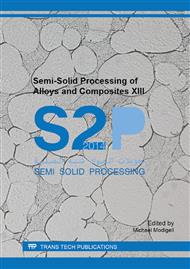p.302
p.312
p.318
p.325
p.332
p.340
p.347
p.355
p.361
Comparison of Microstructure and Mechanical Properties of Semi-Solid Castings Produced Using Billets Made by EMS and SEED
Abstract:
The spheroidal grains in billets used for semi-solid casting are generally manufactured by electromagnetic stirring (EMS) during the casting process. This method however, is not economically applicable for small quantities of the thixo billets. Swirled Enthalpy Equilibration Device (SEED) has been developed as a rheocasting process, and the SEED process is of interest for developing new thixo alloys, as well as for optimizing the thixocasting processes for high quality components. The objective of this paper is to compare the microstructure and mechanical properties of aluminum alloy 319s billets and castings produced using EMS and SEED feed materials. The experimental results show that for as-cast billets made from SEED process, a well-developed spheroidal grain structure is distributed throughout the cross-section of the billet, while for as-cast EMS billets, the grain structure is inhomogeneous, i.e., a dendritic structure was present adjacent to the surface of the billet, while a uniform, spheroidal structure was present at the centre. After the thixocasting process, however, the both SEED and EMS billets have well-developed, spheroidal grain structures. Mechanical properties of thixocast and T61 heat treated components are comparable for the both SEED and EMS billets.
Info:
Periodical:
Pages:
332-339
Citation:
Online since:
September 2014
Authors:
Keywords:
Price:
Сopyright:
© 2015 Trans Tech Publications Ltd. All Rights Reserved
Share:
Citation:


